Routing, is not limited to pedestrians and most of the time is used for routing vehicles.
A query for vehicle routing generally differs from routing for pedestrians:
- the road segments are considered directed,
- Costs can be:
- Distance
- Time
- Euros
- Pesos
- Dollars
- CO2 emittions
- Ware and tear on the vehicle, etc.
- The reverse_cost attribute must be taken into account on two way streets.
- The costs should have the same units as the cost attribute
- cost and reverse_cost can be different
This is due to the fact that there are roads that
are 「one way」.
Depending on the geometry, the valid way:
- (source, target) segment (
cost >= 0 and reverse_cost < 0)
- (target, source) segment (
cost < 0 and reverse_cost >= 0)
So a 「wrong way」 is indicated with a negative value and is not inserted in the
graph for processing.
For two way roads cost >= 0 and reverse_cost >= 0 and their values can
be different. For example, it is faster going down hill on a sloped road.
In general cost and reverse_cost do not need to be length; they can be
almost anything, for example time, slope, surface, road type, etc., or they can
be a combination of multiple parameters.
The following queries indicate the number of road segments, where a 「one way」 rule applies:
Number of (source, target) segments with cost < 0
SELECT count(*)
FROM ways
WHERE cost < 0;
Number of (target, source) segments with reverse_cost < 0
SELECT count(*)
FROM ways
WHERE reverse_cost < 0;
count
-------
870
(1 row)
From the Serena hotel going to the Fish market by car.
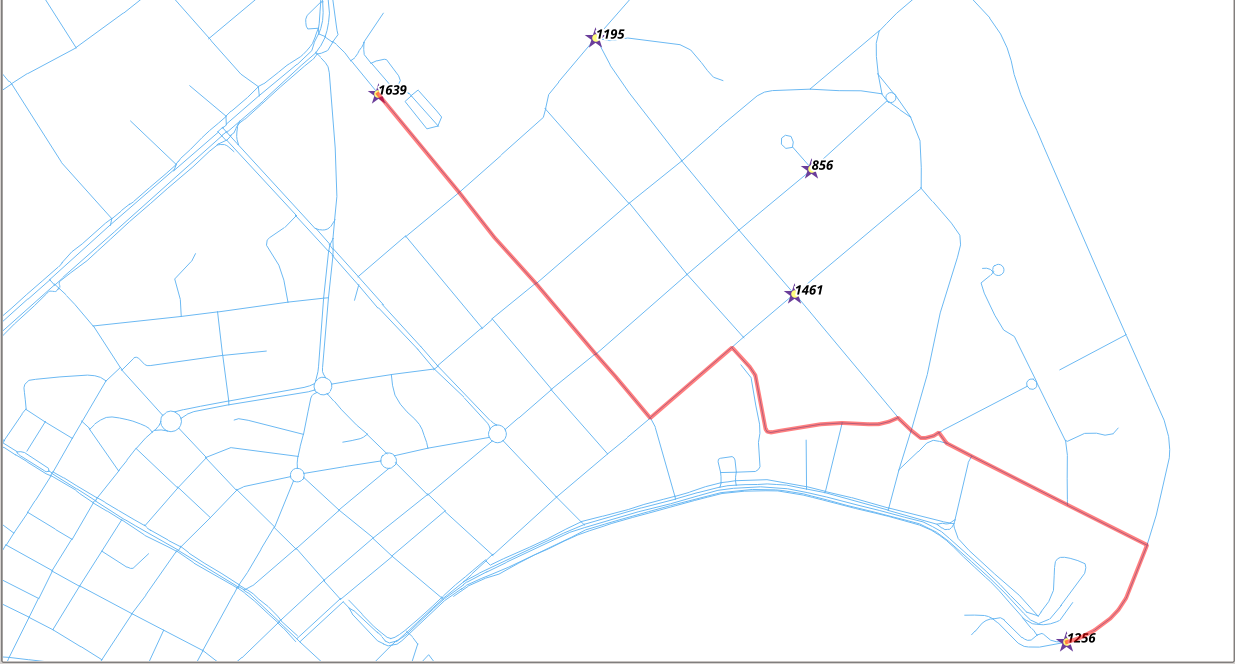
- The vehicle is going from vertex
1639 to vertex 1256.
- Use
cost and reverse_cost columns, which are in unit degrees.
SELECT * FROM pgr_dijkstra(
'SELECT gid AS id,
source,
target,
cost_s AS cost,
reverse_cost_s AS reverse_cost
FROM ways',
1639, 1256,
directed := true);
Solution to Exercise 7
From Fish market going to the Serena hotel by car.
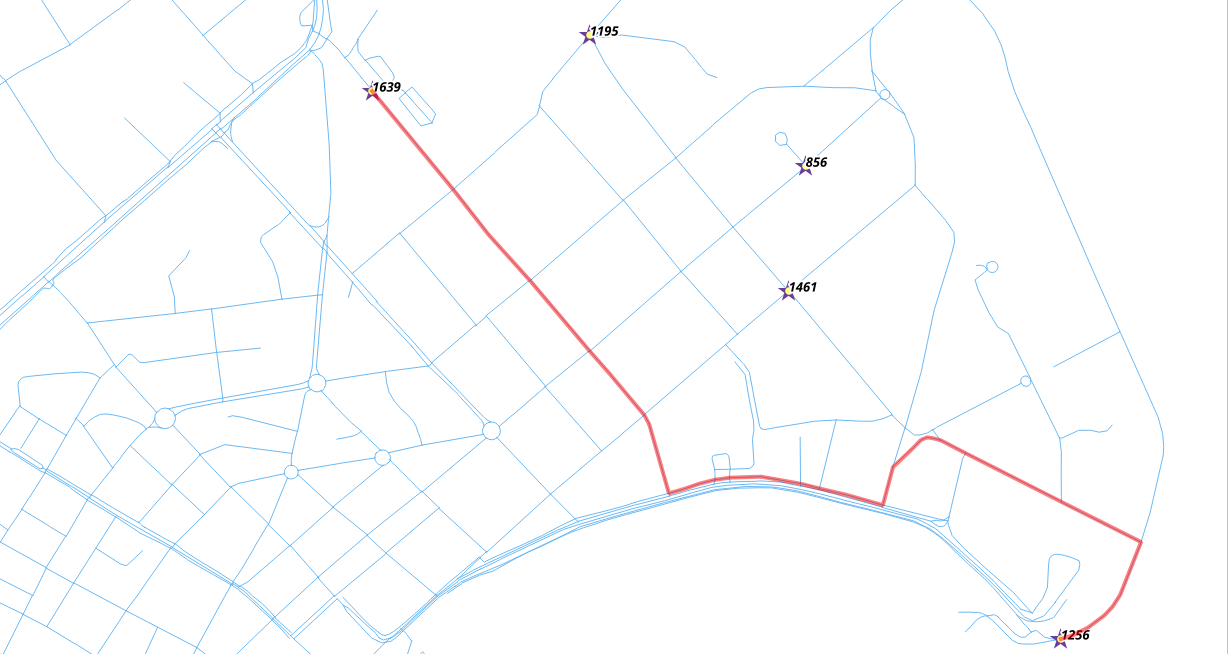
- The vehicle is going from vertex
1256 to vertex 1639.
- Use
cost and reverse_cost columns, which are in unit degrees.
SELECT * FROM pgr_dijkstra(
'SELECT gid AS id,
source,
target,
cost_s AS cost,
reverse_cost_s AS reverse_cost
FROM ways',
1256, 1639,
directed := true);
Solution to Exercise 8
注釈
On a directed graph, going and coming back routes, most of the time are different.
From Fish market going to the Serena hotel by taxi.
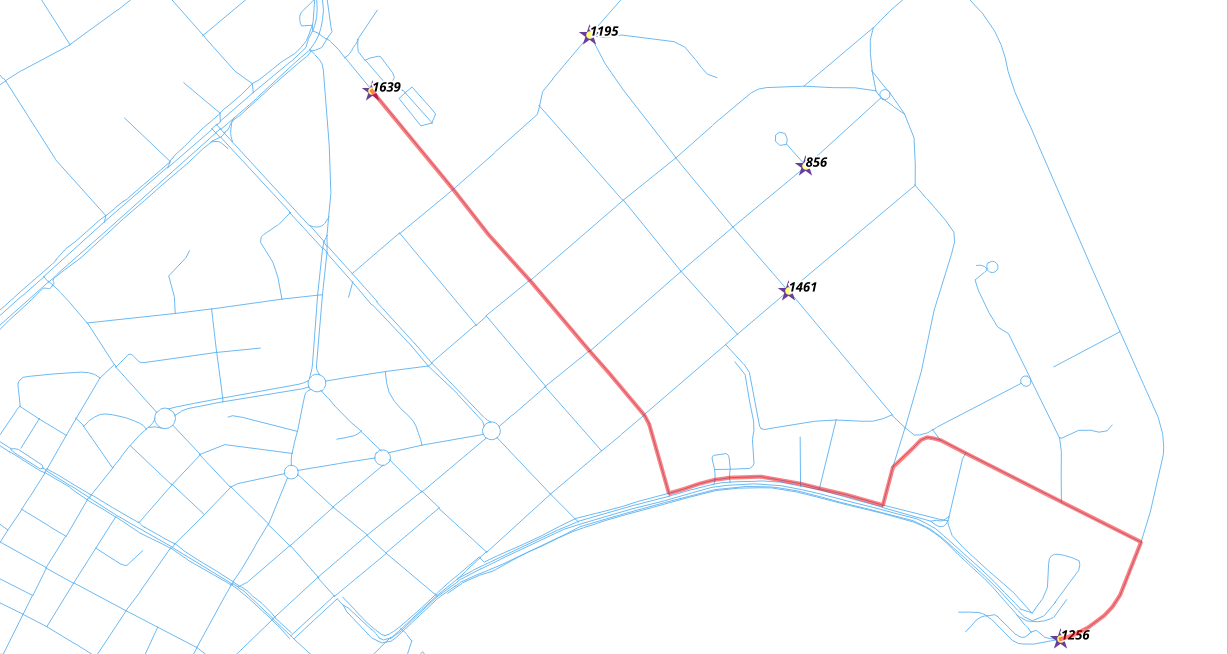
- The vehicle is going from vertex
1256 to vertex 1639.
- The cost is
$100 per hour.
- Use
cost_s and reverse_cost_s columns, which are in unit seconds.
- The duration in hours is
cost / 3600
- The cost in
$ is cost / 3600 * 100
SELECT * FROM pgr_dijkstra('
SELECT gid AS id,
source,
target,
cost_s / 3600 * 100 AS cost,
reverse_cost_s / 3600 * 100 AS reverse_cost
FROM ways',
1256, 1639);
Solution to Exercise 9
注釈
Comparing with Exercise 8:
- The total number of records are identical
- The node sequence is identical
- The edge sequence is identical
- The cost and agg_cost results are directly proportional
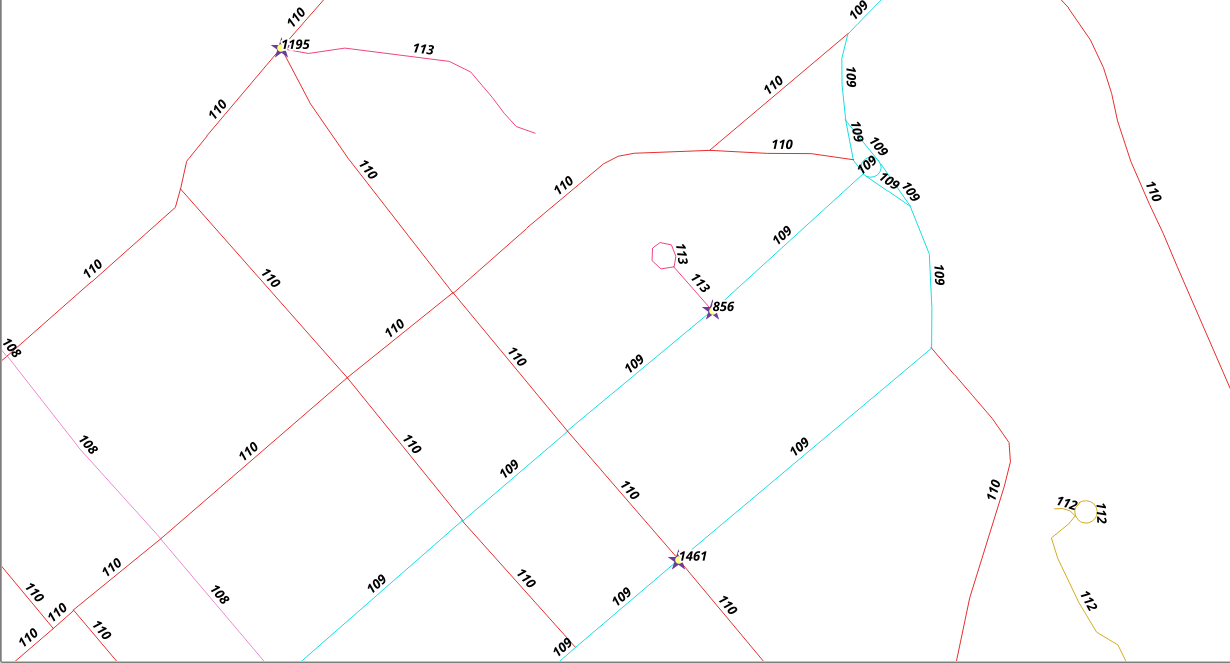
When dealing with data, being aware of what kind of data is being used, can improve results.
- Vehciles can not circulate pedestrian ways,
- Likewise, routing not using pedestrian ways
Will make the results closer to reality.
When converting data from OSM format using the osm2pgrouting tool, there is an
additional tables: configuration
In the image above there is a detail of the tag_id of the roads.
osm way types
SELECT tag_id, tag_key, tag_value FROM configuration ORDER BY tag_id;
tag_id | tag_key | tag_value
--------+-----------+-------------------
100 | highway | road
101 | highway | motorway
102 | highway | motorway_link
103 | highway | motorway_junction
104 | highway | trunk
105 | highway | trunk_link
106 | highway | primary
107 | highway | primary_link
108 | highway | secondary
109 | highway | tertiary
110 | highway | residential
111 | highway | living_street
112 | highway | service
113 | highway | track
114 | highway | pedestrian
115 | highway | services
116 | highway | bus_guideway
117 | highway | path
118 | highway | cycleway
119 | highway | footway
120 | highway | bridleway
121 | highway | byway
122 | highway | steps
123 | highway | unclassified
124 | highway | secondary_link
125 | highway | tertiary_link
201 | cycleway | lane
202 | cycleway | track
203 | cycleway | opposite_lane
204 | cycleway | opposite
301 | tracktype | grade1
302 | tracktype | grade2
303 | tracktype | grade3
304 | tracktype | grade4
305 | tracktype | grade5
401 | junction | roundabout
(36 rows)
Also on the ways table there is a column that can be used to JOIN with the configuration table.
The ways types
SELECT distinct tag_id, tag_key, tag_value
FROM ways JOIN configuration USING (tag_id)
ORDER BY tag_id;
tag_id | tag_key | tag_value
--------+----------+---------------
104 | highway | trunk
105 | highway | trunk_link
106 | highway | primary
108 | highway | secondary
109 | highway | tertiary
110 | highway | residential
112 | highway | service
113 | highway | track
117 | highway | path
118 | highway | cycleway
119 | highway | footway
122 | highway | steps
123 | highway | unclassified
125 | highway | tertiary_link
204 | cycleway | opposite
(15 rows)
In this workshop, costs are going to be manipulated using the configuration table.
From the Botanical garden to the Museum
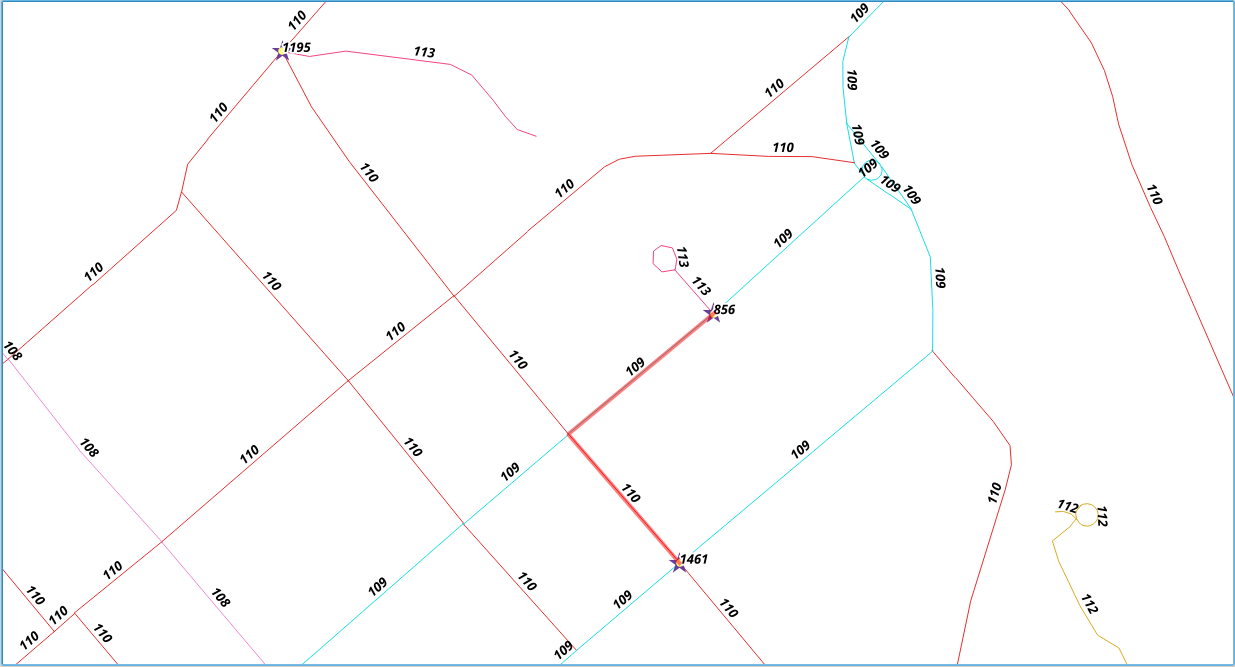
- The vehicle is going from vertex
856 to vertex 1461.
- The vehicle’s cost in this case will be in seconds.
- All roads have a
penalty of 1
- Costs are to be multiplied by
penalty
- Costs wont change (times 1 leaves the value unchanged).
- The
configuration table is linked with the ways table by the
tag_id field using a JOIN.
ALTER TABLE configuration ADD COLUMN penalty FLOAT;
-- No penalty
UPDATE configuration SET penalty=1;
SELECT * FROM pgr_dijkstra('
SELECT gid AS id,
source,
target,
cost_s * penalty AS cost,
reverse_cost_s * penalty AS reverse_cost
FROM ways JOIN configuration
USING (tag_id)',
856, 1461);
Solution to Exercise 10
Change the cost values for the configuration table, in such a way, that the
* pedestrian roads are not used
* Using residential roads its not encouraged.
* Using 「faster」 roads is highly encouraged.
* The penalty values can be changed UPDATE queries.
注釈
This values are an exageration
-- Not including pedestrian ways
UPDATE configuration SET penalty=-1.0 WHERE tag_value IN ('steps','footway');
-- Penalizing with 5 times the costs
UPDATE configuration SET penalty=5 WHERE tag_value IN ('residential');
-- Encuraging the use of "fast" roads
UPDATE configuration SET penalty=0.5 WHERE tag_value IN ('tertiary');
UPDATE configuration SET penalty=0.3 WHERE tag_value
IN ('primary','primary_link',
'trunk','trunk_link',
'motorway','motorway_junction','motorway_link',
'secondary');
From the Botanical garden to the Museum with penalization.
- The vehicle is going from vertex
856 to vertex 1461.
- Use
cost_s and reverse_cost_s columns, which are in unit seconds.
- Costs are to be multiplied by
penalty
- The
configuration table is linked with the ways table by the
tag_id field using a JOIN.
SELECT * FROM pgr_dijkstra('
SELECT gid AS id,
source,
target,
cost_s * penalty AS cost,
reverse_cost_s * penalty AS reverse_cost
FROM ways JOIN configuration
USING (tag_id)',
856, 1461);

Solution to Exercise 11
注釈
Comparing with Exercise 9:
- The total number of records changed.
- The node sequence changed.
- The edge sequence changed.
- The route is avoiding the residential roads that have
tag_id = 110
 Workshop FOSS4G Dar Es Salaam
Workshop FOSS4G Dar Es Salaam





